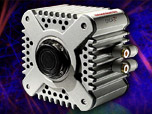Image Galleries
Featured Article
 Electron Multiplying Charge-Coupled Devices (EMCCDs)
Electron Multiplying Charge-Coupled Devices (EMCCDs)
By incorporating on-chip multiplication gain, the electron multiplying CCD achieves, in an all solid-state sensor, the single-photon detection sensitivity typical of intensified or electron-bombarded CCDs at much lower cost and without compromising the quantum efficiency and resolution characteristics of the conventional CCD structure.
Product Information
Interactive Flash Tutorials
Side-On Photomultipliers
In the side-on photomultiplier tube design, photons impact an internal photocathode and eject electrons from the front face. These ejected photoelectrons have trajectories angled at the first dynode, which in turn emits a larger quantity of electrons angled at the second dynode (and so on). Instructions for operation of the tutorial appear beneath the applet window.
The tutorial initializes with a single photon impacting the photocathode and producing corresponding photoelectrons, which then move through the dynode chain. Use the Stop button to start and stop photon flow, and the Gain slider to control the number of photoelectrons in the tutorial. The photoelectrons flow through the dynode chain and eventually are captured by the anode. When the Stop button is activated, the photomultiplier drawing reverts to a new illustration that diagrams photoelectron flow through the photomultiplier tube.
The spectral response, quantum efficiency, sensitivity, and dark current of a photomultiplier tube are determined by the composition of the photocathode. The best photocathodes capable of responding to visible light are less than 30 percent quantum efficient, meaning that 70 percent of the photons impacting on the photocathode do not produce a photoelectron and are therefore not detected. Photocathode thickness is an important variable that must be monitored to ensure the proper response from absorbed photons. If the photocathode is too thick, more photons will be absorbed but fewer electrons will be emitted from the back surface. However, if the photocathode is too thin, too many photons will pass through without being absorbed. The photomultiplier used in this tutorial is a side-on design, which uses an opaque and relatively thick photocathode of precise thickness as well as composition. Photoelectrons are ejected from the front face of the photocathode and angled toward the first dynode. Due to differences in design, side-on photomultiplier tubes often demonstrate higher quantum efficiencies than end-on tubes having photocathodes of similar composition.
In microscopy, the incident illumination is dispersed over a substantial portion of the photocathode, although the sensitivity is rarely uniform over the entire surface. In side-on designs, the upper half of the photocathode is typically 20 to 30 percent more sensitive than the lower half. The number of dynodes present in photomultipliers also varies by design. End-on tubes can have a series of up to 14 electrodes, whereas the side-on designs are usually limited to no more than 9 dynodes. For this reason, side-on photomultipliers do not achieve the high electron gains exhibited by end-on tubes.
Contributing AuthorsKenneth R. Spring - Scientific Consultant, Lusby, Maryland, 20657.
Clay Krauterbluth and Michael W. Davidson - National High Magnetic Field Laboratory, 1800 East Paul Dirac Dr., The Florida State University, Tallahassee, Florida, 32310.






